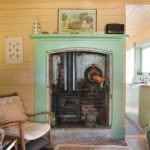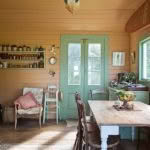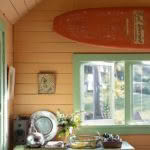How a former shearers’ cookhouse on the East Coast became a peaceful bach escape for the Shanks family
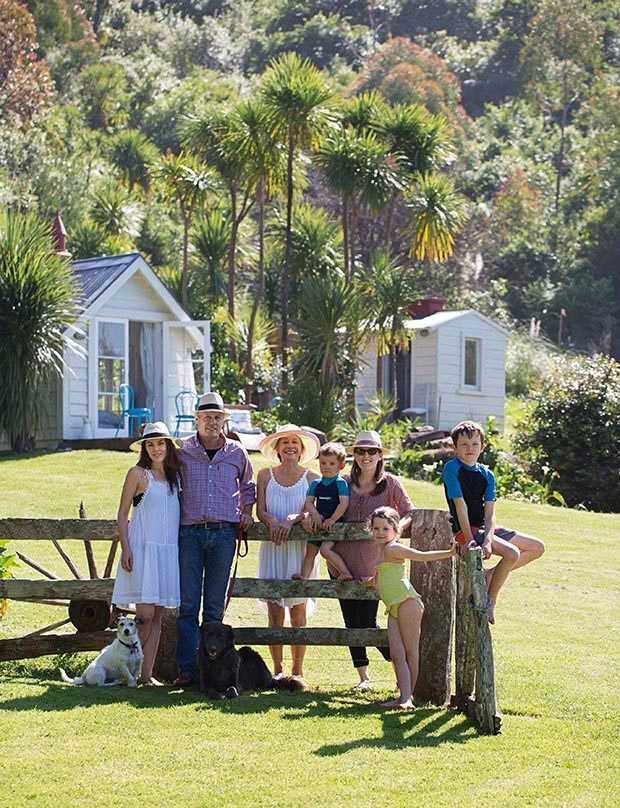
The Shanks family in holiday mode. (From left) Amy Shanks with her dog Russell, Paul with Rod the stock dog, Jo, Angus, Jessie, Madeline and Oscar.
Three generations of one family ride the tides of change on an East Coast beach saturated with history.
Words: Emma Rawson Photos: Tessa Chrisp
There weren’t many things that could surprise an eight-year-old Paul Shanks. But as a passenger in his dad’s Nash Rambler, riding along the tummy-turning East Cape hills to a school sports day, the sight of Anaura Bay’s Motuoroi Island, and the waves breaking over sand the colour of wine biscuits, sucked the breath from his lungs. “I wasn’t easily impressed at that age, but I remember thinking, ‘well, that’s something.’”
Anaura Bay reels people in – even Captain James Cook. An hour’s drive from Gisborne on the sticky-out-bit of Te Ika-a-Māui, the bay was one of Cook’s early landfalls on his first voyage to Aotearoa in 1769.
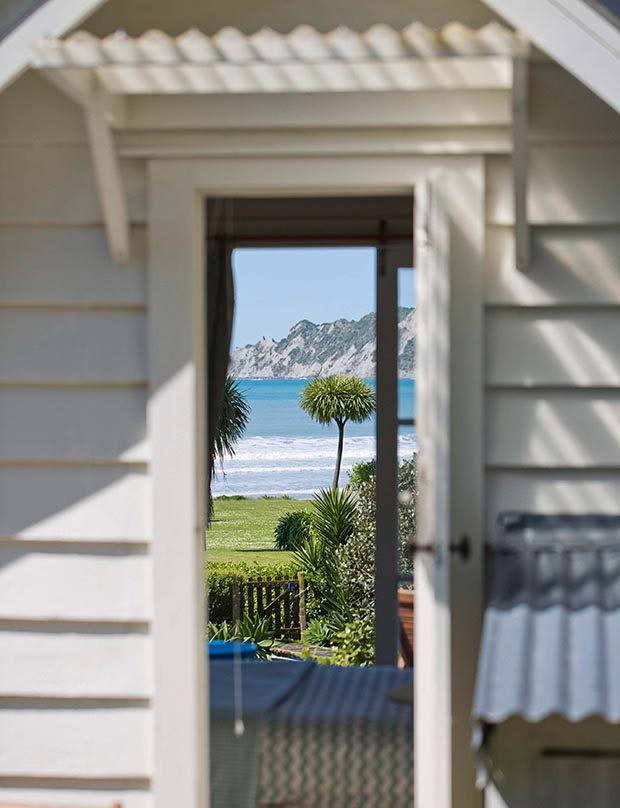
Jo and Paul Shanks’ sleepout was a meat and vegetable storage room in a former life but now it has top-shelf views of the beach and Anaura Bay.
Cook’s initial contact with Māori in Poverty Bay further down the coast and a few days prior to him landing at Anaura Bay had ended in bloodshed with the death of nine Māori. But in the sheltered embrace of Anaura Bay (which Cook called “Tegadoo” in his captain’s log), Pakeha and Māori had a more peaceful encounter.
The Endeavour’s depleted food stores were replenished with kumara, fish and fresh water, and the crew took aboard firewood. Despite being the ship’s salvation, Cook is hardly glowing about Anaura; in his log he says there is “nothing to recommend, I shall give no description of it”.
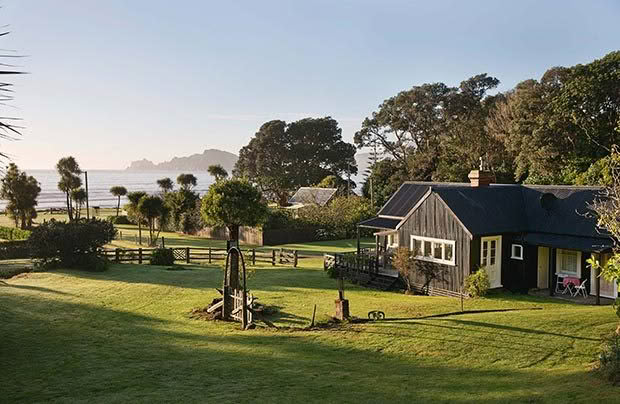
The original shearers’ cookhouse was given a lick of dark grey paint when it became the Shanks’ bach.
While Cook seemed ungrateful (food, water, what more could he want?), the ship’s botanist Joseph Banks saw an East Coast Eden. “The cultivations were truly astonishing… surpass any idea we have formed of them. The ground is completely cleared of all weeds – the mold broke with as much care as that of our best gardens. The sweet potatoes are set in distinct little molehills which are arranged in some straight lines.”
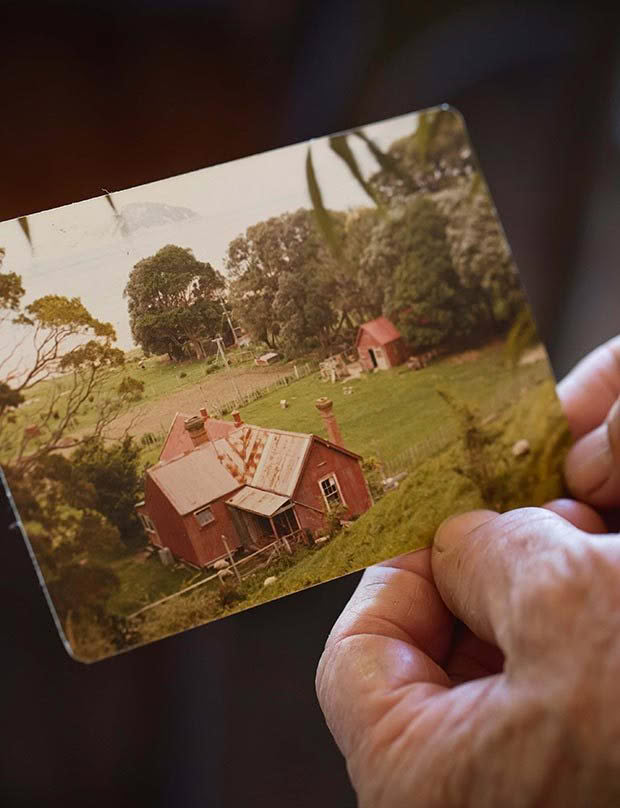
Even now, Anaura Bay keeps some of its innocence: in the busiest two weeks of summer between Christmas and New Year’s Eve, when the DOC campsite and the motor camp are bustling, the beach is sleepy by New Zealand standards. But 130 years ago, this was a bay of toil and labour as farmers and their labourers drove horses and carts through the ocean swell to load bales of wool onto tenders for delivery to ships moored beyond the breakers.
Anaura’s 4000-hectare Waipare sheep station was owned by the Williams family for more than 75 years before Paul’s parents bought it in 1956. “Growing up here was like being in a Famous Five book… a child’s paradise with a woolshed, a shearers’ quarters and cookhouse, abandoned machinery everywhere and the bush and the beach. It was ripe for kids’ adventures. My brother and I looked for Māori artefacts but never found any.”
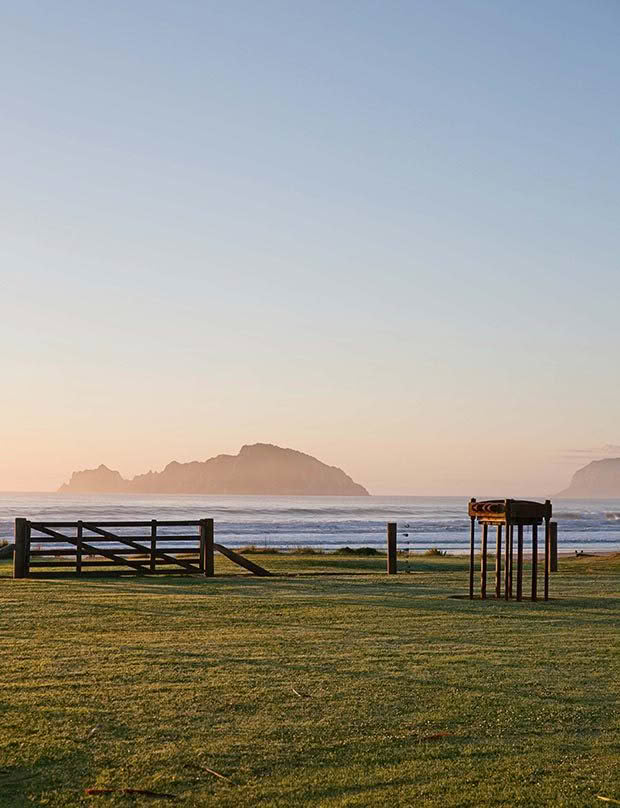
The old wool machinery still stands at the end of the beach, facing Motuoroi Island. The machine was used to bind two bales of wool together with steel bands. These were then loaded onto tenders via horse and cart. It was tiring work as the wool bales weighed about 150 kilogrammes each.
Paul’s parents sold most of the land in 1966 but kept the historic 1880 homestead and five hectares of beachfront farmland for their retirement. Jo, Paul’s wife, has also answered the call of Anaura. But it was Paul, a dashing young polo-playing farmer whom she met in 1974 at a friend’s wedding who first intrigued her. He invited her to Anaura Bay for New Year’s Eve and he stills laughs that she checked with his mum before accepting the invitation.
“Mum said there was a polite girl on the phone with a mouse voice saying she’d like to come to our party… little did Jo realize what she was in for,” says Paul.
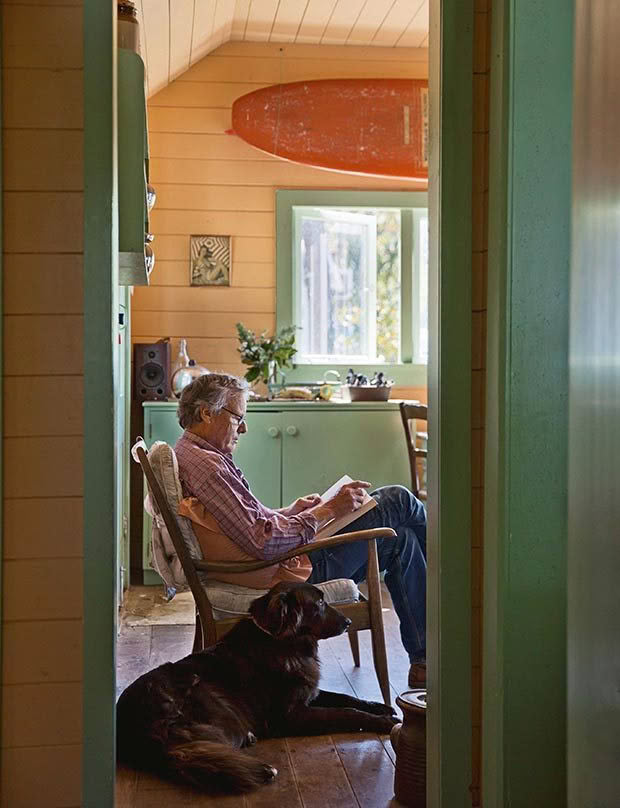
Bob Davies surfboard bought in 1966 – Paul’s last year at school – never saw much time in the water so it now hangs as a decoration, along with a framed 1950s pin-up girl poster, and a seagull ornament and retro clock (both below) – all found on Trade Me.
Jo came for the weekend and stayed for the week. The jeweller’s daughter from Napier with an anthropology degree and the farm boy who didn’t like cold water and only pretended to be able to surf to get the girls, hit it off. He wasn’t put off by her delicate townie ways when petite Jo was thrown from his lolloping polo pony on the beach. She wasn’t put off by the country boy’s two left feet.
“At the New Year’s Eve party we danced on the lawn, and I soon realized that Paul wasn’t the world’s best dancer but it didn’t matter and I sort of floated around. I didn’t want to leave him or this place.”
- They kept the original stove in what is now the lounge.
- Paul and Jo moved the kitchen to the front of the house so the family could see the sea while eating at the table.
- The rooms were originally crudely spray-painted a dirty white, but Jo chose heritage shades of orange and mint green to give them a retro vibe.
She followed Paul back to his own farm at Pukerewa on the steep slopes inland from Whangara (north of Gisborne). “I washed his best army surplus working trousers for him, which stunk because he’d been dagging sheep all day. I thought I was doing the right thing so washed them in hot water but they ended up shrinking so much they only reached the middle of his calves.
I think he kept wearing them just to embarrass me. I wasn’t destined to be a good farmer’s wife, but that didn’t matter.” Four months after the New Year’s Eve party at Anaura, they were engaged.
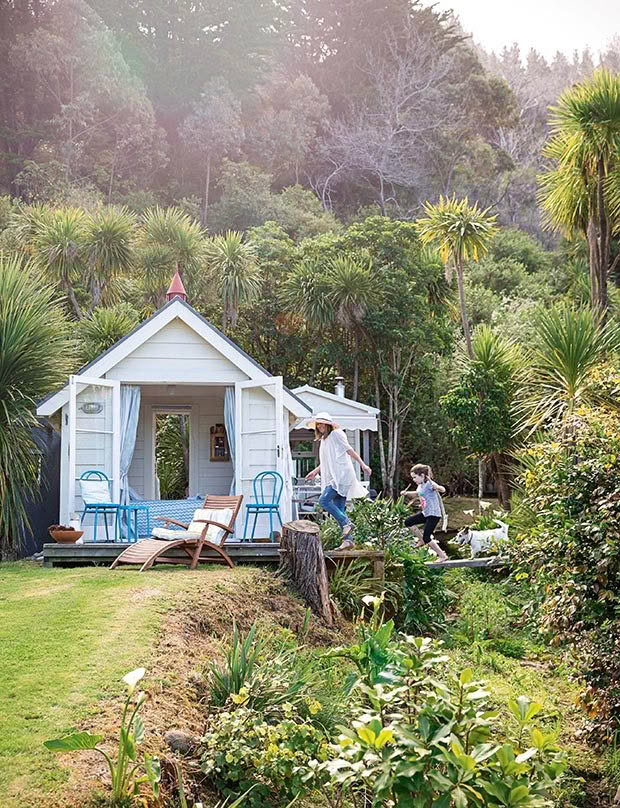
Anaura Bay remained the family retreat from the hard yakka at Pukerewa where “the hills sure kept me fit”. When Paul’s dad died, and his mum moved to town, Paul and his siblings had to decide what to do with the land at Anaura Bay. No one could bear to part with it but there were difficult decisions to be made.
“In the mid-1980s, farming was going through a tough time and retaining the old homestead as a holiday home was unaffordable, but we had to do something.” The family sold the homestead but kept half the land, which they then cross-leased and sold to wider family and friends. Paul took the original shearers’ cookhouse; his cousin took a patch of land up the hill; friends Roger Murphy and Sam Willock took beachside spots, as did Paul’s mum who built a small bach where the old chook house once stood.
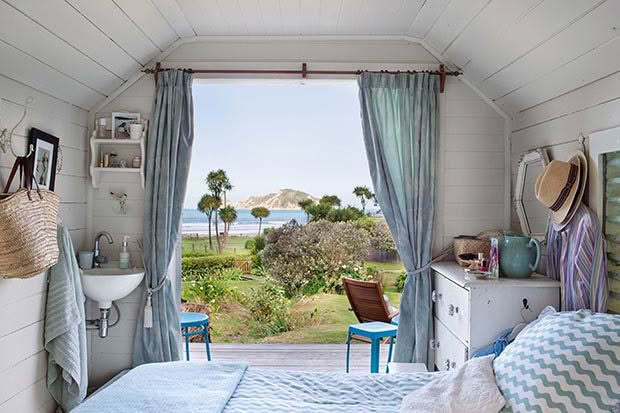
Now Paul’s sister Mandy and husband Paul live there eight months of the year, and daughter Abby also visits often. “It was hard saying goodbye to the old homestead, but this was our way of protecting the history of this place,” says Paul.
It took some effort to transform the cookhouse to a laid-back bach. It was as though the sweat of hulking men who were once fed a hot meal here after a hard day shearing was infused in the kauri walls. The original kitchen was boxed inside without a view of the sea, and it was a right rigmarole to get the old fireplace to work. Pots and pans for cooking were hung on the wall from a string and at night rats made a drumming sound running along it.
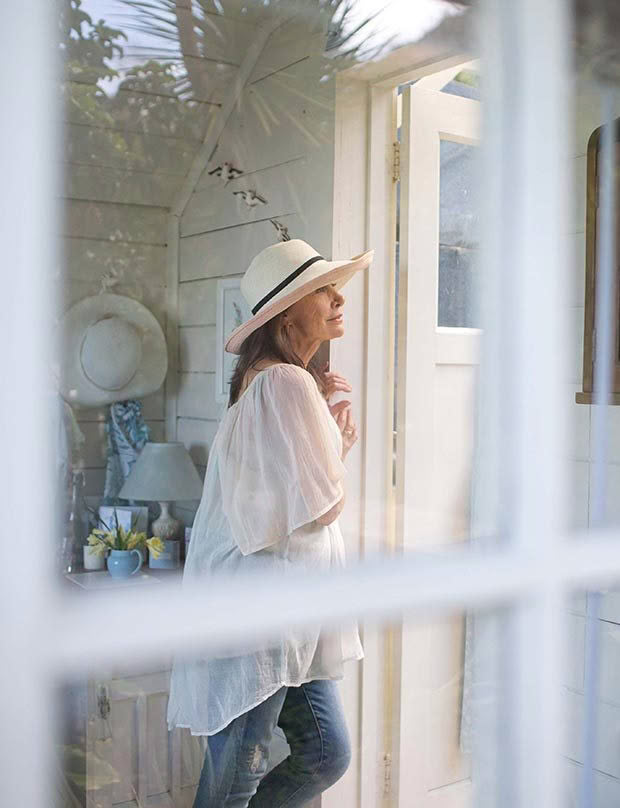
Even worse, opening a chest of drawers might reveal a nest. When an Australian gum tree (planted along with many other exotics in the Williams era) crashed into the building after a storm, the roof and chimney had to be repaired.
But floors were scrubbed, rat traps baited, walls painted and doors opened to fresh, salty air. Over the years, as Jo and Paul brought their own kids, Amy, Jessie and Jake, to the bach “Mummy and Daddy Shanks” (as they are known to their children and to anyone else who visits), slowly modernized the building. They were careful to retain the heritage features. Every piece of furniture is repurposed and salvaged from a former life.
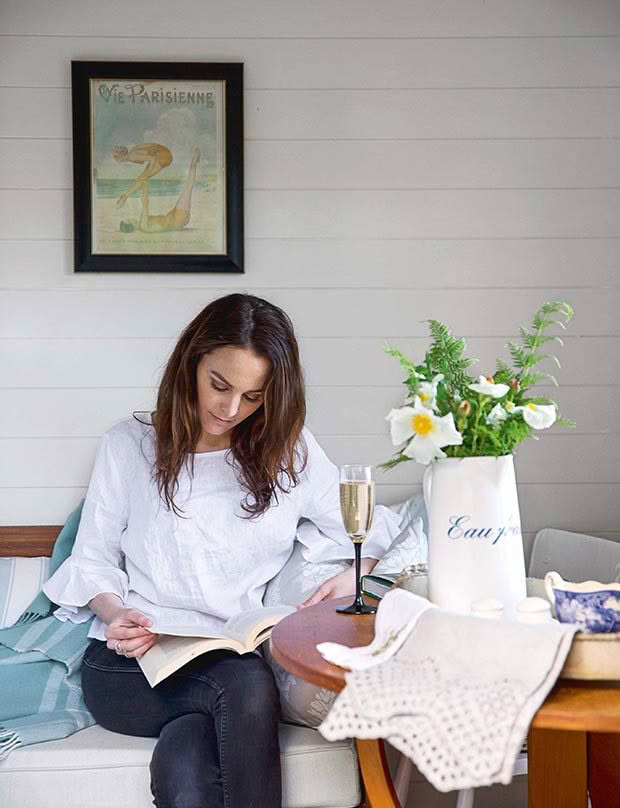
The former Poverty Bay Golf Course hut, transfered to the Shanks’ site, makes a great reading spot for Amy, a journalist and digital marketer. She has no shortage of friends and flatmates wanting to spend time at Anaura Bay.
“This place is so special we didn’t want to spoil its character,” says Jo. A dishwasher in the kitchen is one of the few traces of modernity. “I insisted on the dishwasher. People told me washing the dishes is a bonding exercise, but whoever bonded doing dishes?”
When the kids were little, beach-lover Jo was the kind of mum who was knee-deep in the sand, building sandcastles and exploring the rocks like one of the children.
Locals know her as “the lady who likes to dance on the beach”. “I love to dance, and this place has such beauty. I truly believe this bay has a soul; it invokes a sense of freedom,” she says.
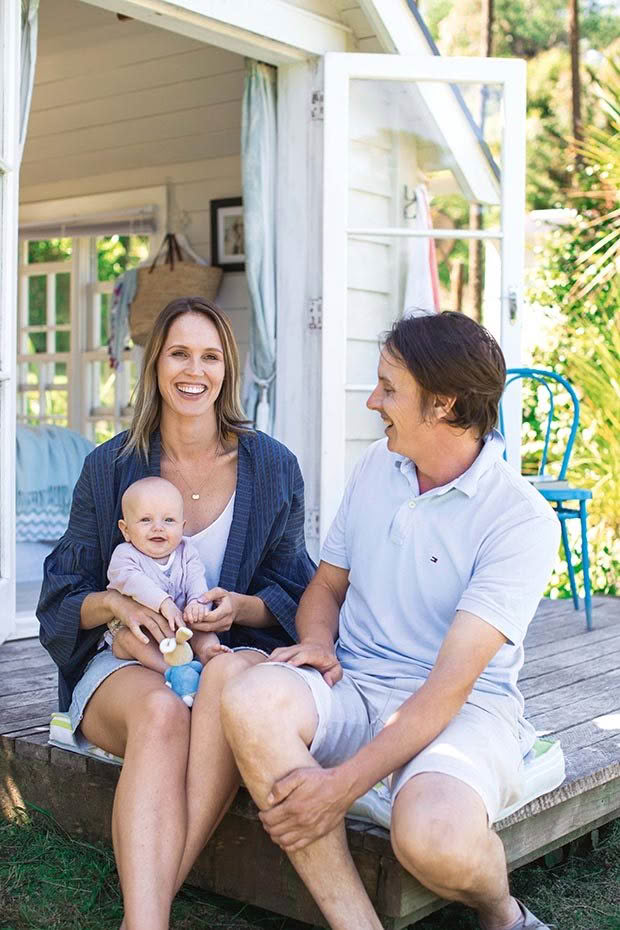
Jake and his wife Alex work with Jo and Paul on the Gisborne citrus orchard. It’s fitting they named their baby Clementine.
As the kids grew older, they started bringing their own friends to Anaura Bay, and later wives, husbands, and in-laws. To help house the expanding family, Paul found three little huts, all with the same heritage A-line stud to move onto the land. The first building was, in a former life, a meat and vegetable storage room from a demolished East Coast homestead.
The second little hut was once a portable prison sleepout at Tongariro/Rangipo Prison near Turangi, complete with two bunks and iron bars across the windows. The third shack was an old grain storage hut Paul spotted sitting unused and dilapidated near the Poverty Bay Golf Club. Each little cottage was decorated in heritage colours to blend in with the original house.
Now that Mummy and Daddy Shanks are now Nana Jo and Grandad Paul to daughter Jessie and her husband Mark’s kids (Madeline, Oscar and Angus) and son Jake and his wife Alex’s daughter Clementine, things are a little busier at the bach. So Jo and Paul take the former storage room as their little hideaway.
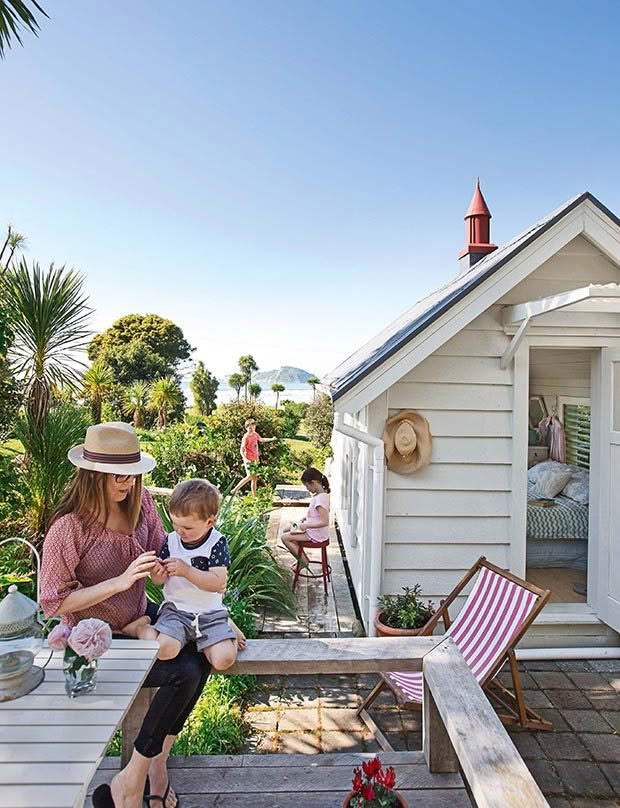
The three huts on the property make great play spots and hiding areas for Jessie’s kids Oscar, Angus and Madeline.
“When we first dragged it in on the trailer, Jake laughed at us and said ‘you’ll never even fit a bed in there’, but we did. It took a bit of spacial awareness to work out how to move around in it, but now we can be there on our own so the kids can enjoy the house,” says Jo. Adds Paul: “We love people having people here over the summer; everyone who visits just gets it – there’s a special feeling about this place.”
ZEST FOR LIFE
Twenty years ago, Paul decided he needed a change from sheep farming and the family uprooted from rural Pukerewa to a rundown orchard on the outskirts of Gisborne. Despite not knowing the first thing about horticulture, Paul and Jo’s lanolin-soaked hands grew green fingers, and they pulled out the old and tired existing stone-fruit trees and planted citrus, navel oranges, yen ben lemons – popular with chefs and foodies – and afourer mandarins (a late-season variety in stores over summer).
After a slow start, the orchard is now nearing full production and the couple sell their produce to Turners & Growers, mainly for the local market but with some exports of lemons and navel oranges to Australia and Japan. The city move also saw Jo train in massage therapy, and she now runs a clinic in a little cottage surrounded by citrus blossoms. Though she loves the country, the move to the city was great for Jo.
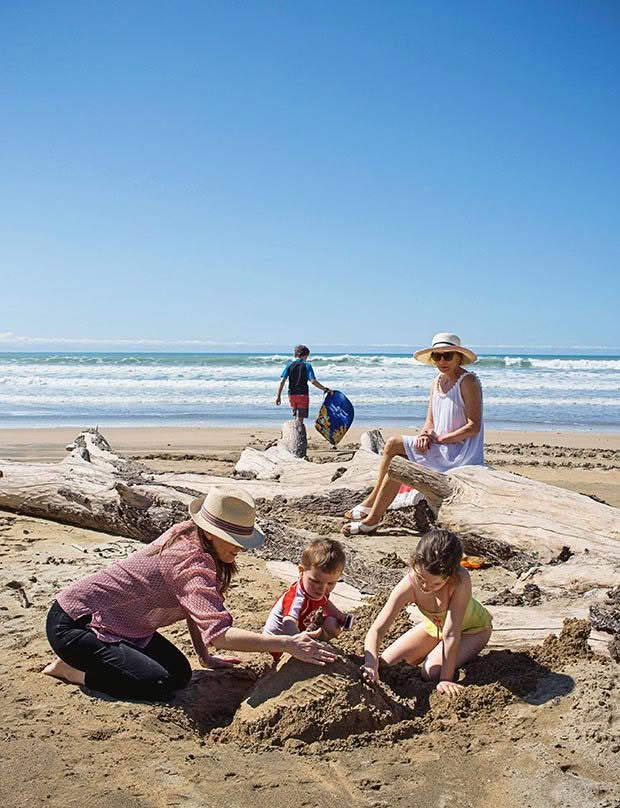
“I was always on the beach with my kids when they were young, and the grandkids are all beach babies,” says Jo. Though none of the family has ever been great surfers, they do water-ski beyond the breakers.
“As an Aquarian, I did not realize how much I missed people, and how I craved interaction with people from different walks of life and with different ideologies. I think that’s why I’ve always loved Anaura because so many people always wanted to stay.” Guests at the bach might be lucky enough to receive one of Jo’s legendary shoulder rubs or Paul’s yen ben cocktails.
YEN BEN LEMON COCKTAIL
Place a cube of sugar in six champagne flutes. Purée three yen ben lemons, skin and all, to create a frothy lemon-juice syrup (This won’t work on lemons with thick pith, such as meyer.) Fill each glass quarter full with juice and top with sparkling wine. Add a sprig of mint to garnish. Makes 6.
A DOG’S LIFE
Amy’s dog Russell lives with her in Hawke’s Bay but adores playing fetch on the beach and having free rein of the Shanks’ bach. The jack russell/ fox terrier actually hails from Tolaga Bay, a small township just 15 minutes’ drive from the beach house.
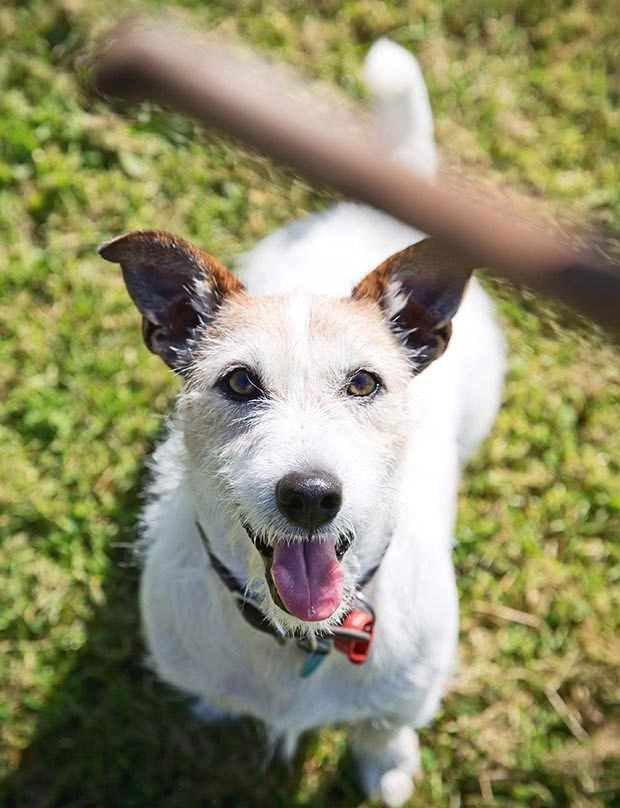
Amy has always had a soft spot for canine companions and was known to steal working-dog pups from the farm kennels when she was little. A love of dogs runs in the family; Paul also took place in sheep dog trials when the family lived in Pukerewa, trialing the farm’s huntaways.
WHAT I’LL BE DOING
Jo: “Reading by the rocks, swimming, walking the dogs and being a very diligent grandmother with eyes in the back of my head when the kids are near the water.”
Paul: “Fishing, reading, and swimming (but only when it’s over 30 degrees).”
WHAT I’LL BE LISTENING TO
Jo: “Leonard Cohen or Lionel Richie. We always seem to gravitate to the old stuff while at the beach.”
Paul: “Dire Straits with a beer in my hand, watching the comings and goings on the beach.”
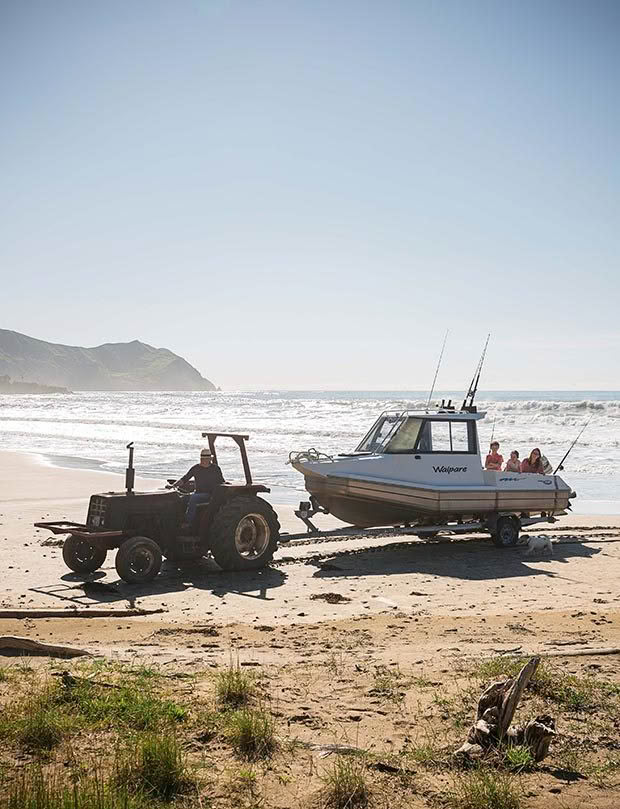
The Shanks’ boat Waipare is named after the old farm.
WHAT WE’LL BE EATING
Jo and Paul: “Fresh fish caught on the boat at our favourite spot – tarakihi, snapper or, if we are really lucky, hapuka. During the summer, we make lots of salads, pasta for all the visitors and have steak and sausages handy for when the fish aren’t biting.”
WHAT WE’LL BE PLAYING
Paul and Jo: “Cricket with the grandchildren – underarm bowling of course – and towing the grandkids on the seabiscuit. The adults all like to water ski, but the seabiscuit is a good place for the kids to start.”
Love this story? Subscribe now!
 This article first appeared in NZ Life & Leisure Magazine.
This article first appeared in NZ Life & Leisure Magazine.
